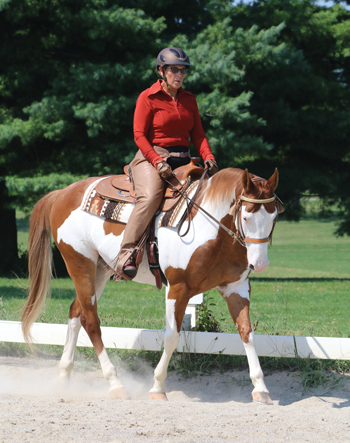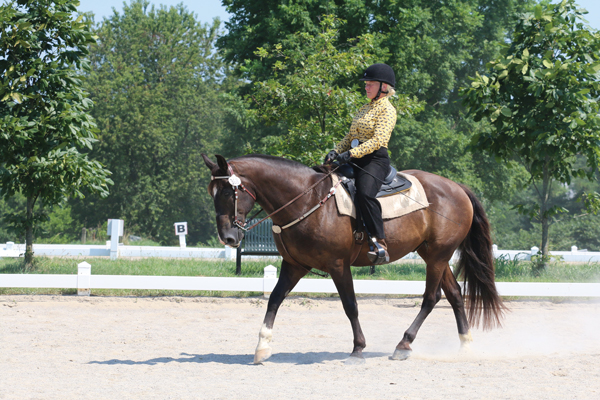
If you’re the type of person who enjoys setting a goal and tackling each step to achieve it, chances are good you’ll find a western dressage show quite satisfying. For the newcomer, barriers to entry are low, but the payoffs in terms of training refinement and partnership with your horse are enormous.
Below are some tips and guidelines to get you started or further your involvement with the sport.
Making Contact
The first question that arises for most people, especially those coming from other western disciplines like reining or pleasure showing, is how much—or how little—contact the horse and rider should have with the bit.
The short answer is a slight positive tension. The longer answer is that it all depends on how ideal the horse’s body carriage and gaits are. In other words, slackness or drape in the reins will not be prioritized above the horse moving with correct rhythm, body mechanics and alignment.
A western dressage horse moving correctly on the bit should stretch into the contact. He shouldn’t be shown with exaggeratedly draped reins. Instead, there should be light rein tone evident. It should appear that the horse is seeking a feel of your hands, with his neck arching and stretching forward from his body.
This is called “looking through” the bridle. As the horse progresses through the levels of training and showing, it’s expected that the rein contact will become lighter as a result of attaining perfect posture and balance. At this point, the reins will appear nearly loose.
Riding one- or two-handed is permitted, but you must perform the entire test without changing back and forth. Curb and snaffl e bits are permitted, with snaffle bits being most common.
Using strong, visible rein cues, constantly bumping the bit, or causing a horse to gape his mouth are considered serious faults. Special emphasis is given to a quiet mouth with head carriage that reflects the appropriate degree of collection and balance for each individual horse. This means the judge takes account of your horse’s natural conformation and balance when evaluating his specifi c outline or frame during competition.

Western Dressage Movement
The western dressage horse should demonstrate a full, swinging stride in all gaits with the hind feet coming forward and landing under the rider. He should move with impulsion, a forward-thinking attitude, engagement and looseness.
The general assumption is that a western dressage horse moves slowly, but this isn’t necessarily the case. A horse that moves well, as noted above, is more important than how rapidly or slowly he jogs or lopes. Slow-moving gaits are not an end goal unto themselves; they should be proof of balance, the result of correct training that includes schooling in lively working gaits.
A correct tempo for each western dressage horse differs according to his individual conformation, limb length, and ability to flex his hindquarters. As your horse’s balance and strength increase and he’s able therefore to carry more weight on his hindquarters, his tempo will naturally slow down. What he gains in loftiness and joint flexion and a softly swinging back, he trades for the quicker gaits of an undeveloped, unbalanced horse.
Competition Notes
As you prepare for a western dressage test, it’s important to keep in mind that this quality of movement is what you will be primarily evaluated on. A successful test is not just the ability to ride an accurate pattern, though that is a component of what judges look for. A much larger part of the evaluation comes from consistent, high-quality gaits and movement demonstrated throughout the pattern.
For competitions, working western attire and equipment are the norm, as opposed to flashier show-ring styles. A clean pair of riding jeans and plain long-sleeve shirt will get you started in the sport. Chaps, chinks, and helmets are optional.
Western dressage was officially branded in the U.S. in 2010, and in 2013, the U.S. Equestrian Federation named the Western Dressage Association of America (WDAA) an affiliate organization. At whatever level you choose to participate—locally, regionally, or beyond—your horse’s athleticism and longevity will bloom.
This article about western dressage originally appeared in the October 2019 issue of Horse Illustrated magazine. Click here to subscribe!






